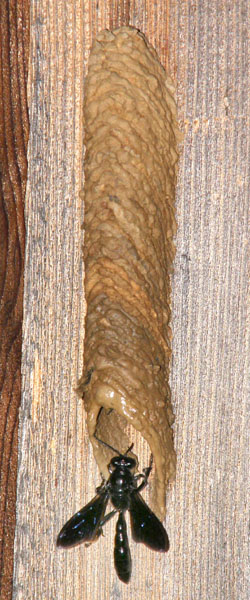Organ-pipe mud-daubers
Order: Hymenoptera
Family: Sphecidae
Genus and species: Trypoxylon politum Say
Organ-pipe mud-dauber and nest Organ-pipe mud-dauber wasps occur in the eastern United States from Maine to Florida west to Kansas and Texas. Typically, females build elongate, tubular mud nests under bridges and eaves, on protected rock faces, in tree holes, and on other smooth, shaded surfaces with a nearby source of mud and adjacent woods. The nests are often built as clusters of contiguous mud tubes resembling organ pipes. After alighting at her quarry, the female lunges into the mud with her mandibles spread. She scoops up a quantity, which is then passed to her forelegs. A complete load is gathered with about 8 lunges. The female forms a strip of mud on the orifice of the tubular nest with each load, alternating from one side to the other. Nest construction is often accompanied by bursts of buzzing that are amplified by the hallow nest. The females provision each cell of the nest with paralyzed spiders as food for their offspring. They hunt mostly orb-weavers in nearby woods, but they also take a few wandering spiders.
There are, however, several other ways to obtain a nest, rather than building a new one. One female may take over the nest of another, or two females may jointly provision the same nest. A female might engage in nest parasitism, in which she replaces the egg in another female’s nest with her own. Finally, wasps may utilize existing cavities, such as hollow stems.
Males remain in the nest during most of nest construction and throughout provisioning, guarding it from intruders, including other organ-pipe mud-daubers. When provisioning is complete, the male and female mate in the nest, and the female lays an egg and seals the cell with a mud partition. The female then provisions the next brood cell in the nest. Eggs hatch in a couple of days and the larvae consume the provided food in about 5 days. Organ-pipe mud-daubers are partially bivoltine; some wasps produce offspring that emerge in late spring or early summer and others produce overwintering offspring. A 4-6 inch nest can be built within 24 hours. A typical pipe contains 3-4 cells, and a typical nest includes a cluster of 5-7 pipes. Male-female bonds usually persist only through the completion of a single tube. Males remain in the nest both day and night, leave from time to time for only brief periods. Females visit the nest only to build and provision. They are not found in nests at night or during the daytime in stormy weather.
Organ-pipe mud-daubers rarely sting unless seriously molested.

